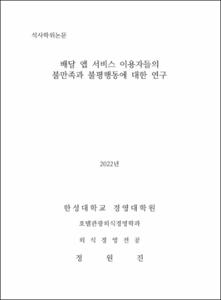배달 앱 서비스 이용자들의 불만족과 불평행동 대한 연구
= A study on dissatisfaction and complaining behavior of delivery app service users
- Appears in Collections:
- 호텔관광외식경영학과 > 1. Thesis
- Files in This Item:
-
-
Download
 200000591766.pdf
기타 데이터 / 989.06 kB / Adobe PDF
200000591766.pdf
기타 데이터 / 989.06 kB / Adobe PDF
-
Items in Repository are protected by copyright, with all rights reserved, unless otherwise indicated.